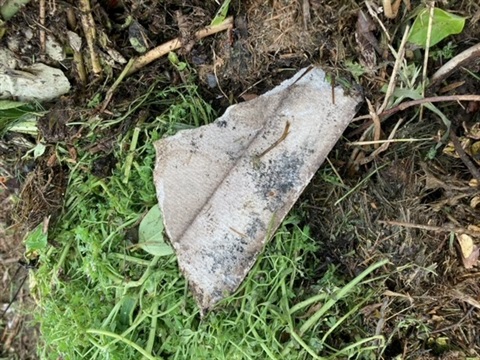Asbestos kills: a reminder about responsible disposal
Published on 24 October 2022

Asbestos is a deadly material and inhalation of asbestos fibres can cause asbestosis, mesothelioma and cancer. Due to these dangers, its safe removal and disposal are very important.
It is common to discover asbestos materials in, around or under older homes so if you do suspect you have this issue, and are concerned with health risks, Council recommends you contact an Occupational Hygienist or other qualified consultant to sample and analyse the material. If the material does contain asbestos these qualified persons can also provide advice on how to manage the risks associated with the material.
Do not:
- Put asbestos in your wheelie bins
- Mix asbestos with other types of waste and take to the tip
- Conceal asbestos in waste loads taken to the tip
- Bury asbestos on your land
The handling and storage of asbestos waste at worksites is regulated by WorkCover NSW, while the storage, disposal and transport of asbestos waste at non-worksites is regulated by the NSW Environment Protection Authority.
Council Landfill facilities must be contacted before asbestos products are taken there.
At no time is asbestos permitted to be disposed of anywhere other than at a licensed landfill facility. Failure to comply with this requirement may result in the issuing of Penalty Infringement Notices or could impose fines.
What is Asbestos/ACM (asbestos-containing materials) Waste?
Asbestos is a generic term for a number of fibrous silicate rock-forming minerals. As a naturally occurring rock fibre, asbestos is mined then broken down from mineral clumps into groups of loose fibres.
Airborne asbestos fibres are small, odourless and tasteless. It presents a health risk when it crumbles and the fine fibres are breathed into the lungs.
Buildings, houses and flats erected before the mid to late 1980s may contain asbestos.
Examples of where asbestos can be commonly found in buildings include:
- Fibro sheeting (commonly found in older garages, bathrooms, kitchens, laundries and external walls)
- Roofs (including eaves and gables) and roof coverings
- Vinyl tiles and backing
- Guttering
- Drainage and flue pipes.
A number of other substances may be present particularly in older buildings that may present health risks if disturbed during renovation or demolition work including but not limited to:
- Lead paint (often in paints used in houses built prior to 1970)
- Synthetic Mineral Fibres (used for thermal and acoustic insulation, and reinforcing agents)
- PCBs (found in older fluorescent light fittings, transformers and capacitors)
There are special conditions of development consent imposed by Council for demolition, renovation, re-cladding or brick veneering buildings due to the possibility of asbestos. This is to ensure the safety of workers and neighbouring residents and the homeowner.
Removal and Handling as Part of a Development Application
Council normally requires a licensed asbestos removal contractor be used for the removal of asbestos in all building work that requires development approval and encourages home owners to use licensed contractors in all other circumstances.
Council normally requires a Hazardous Substances Audit (and if hazardous substances are present a Hazardous Substances Management Plan) be prepared for all development applications that involve the demolition of a building. Demolition means the defacing, destruction, pulling down or removal of that building in whole or in part.
Removal and Handling of Asbestos that is NOT Part of a Development Application
- Treat all fibro sheets as if they contain asbestos unless tested
- Use a licensed asbestos removal contractor to remove all materials containing asbestos
- Recommendations are enforced on all development approvals issued by Council
- Since 1 January 2008, a bonded asbestos licence has been required to remove more than 10 square metres of bonded asbestos material
If asbestos containing material is in sound condition and left undisturbed it generally will not present a significant health risk. If asbestos fibres remain firmly bound in a solid cement sheet or structure such as in ‘fibro’ sheeting, you do not usually need to remove the fibro or even coat it.
Reminder: Landfills must be contacted before asbestos products are taken there.
If you are concerned about how asbestos is being handled, please contact Council.
Under no circumstances should homeowners disturb, or attempt to take samples of any material that is suspected of containing asbestos. Any sampling should be conducted by an appropriately qualified asbestos specialist only. See the list at the WorkCover website: https://www.safework.nsw.gov.au/hazards-a-z/asbestos
Property testing undertaken by a licensed asbestos assessor is the best and safest way to determine whether or not a property contains loose-fill asbestos insulation.
Further information can be found at www.fairtrading.nsw.gov.au